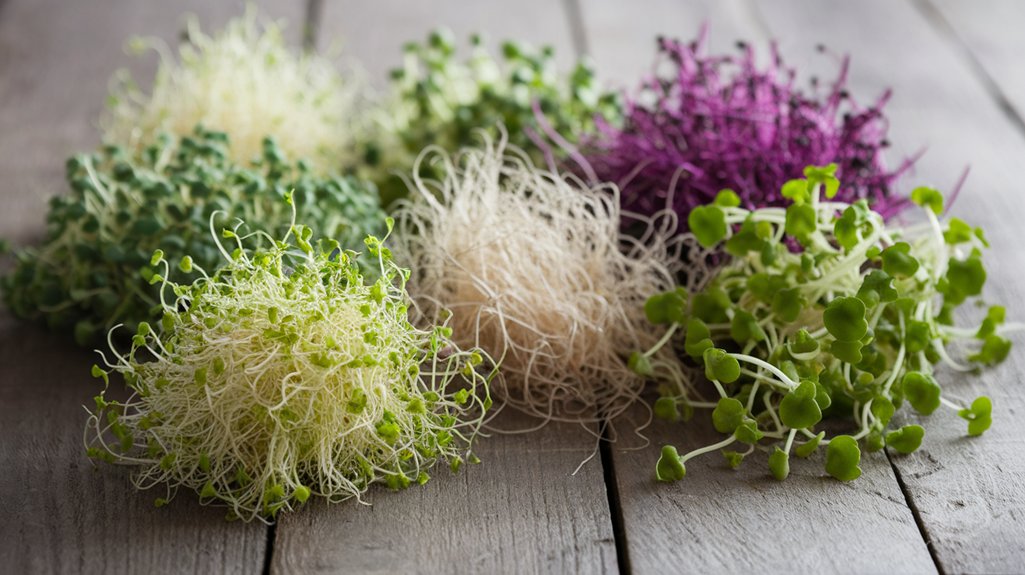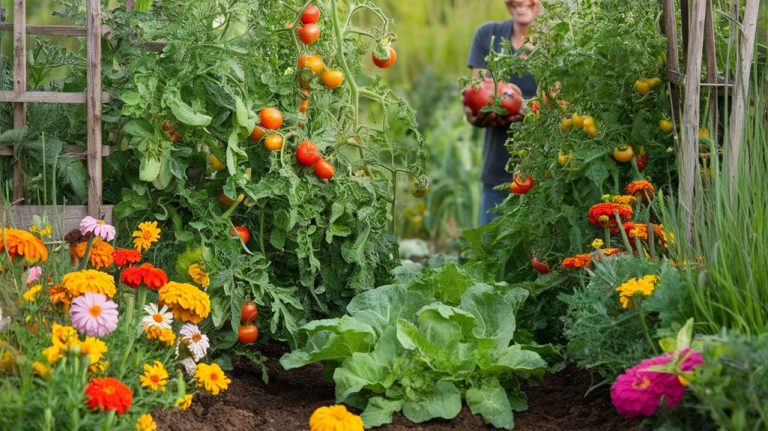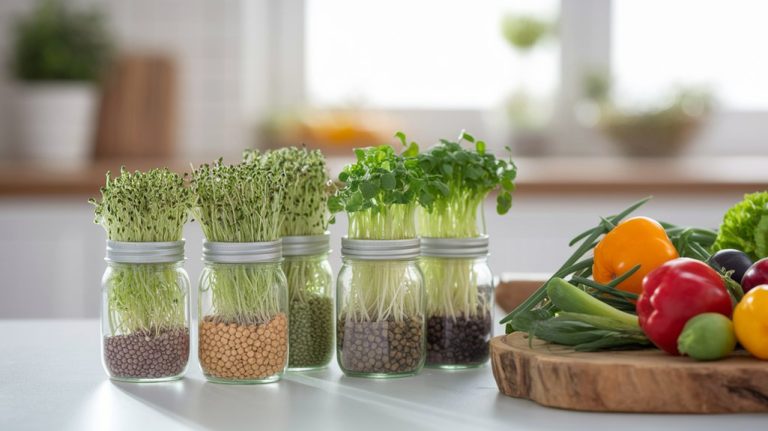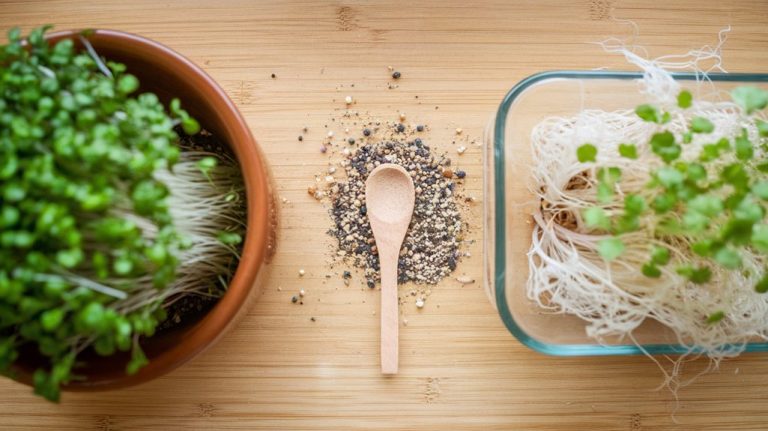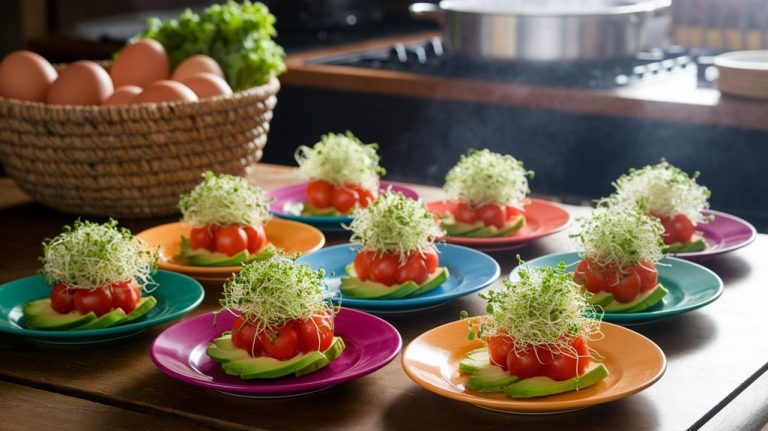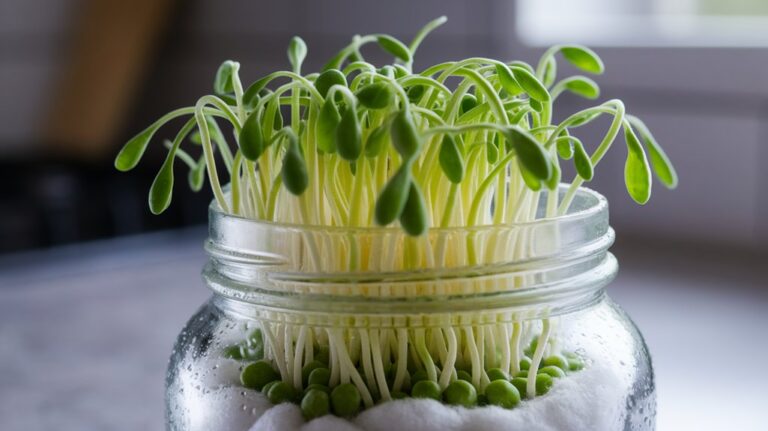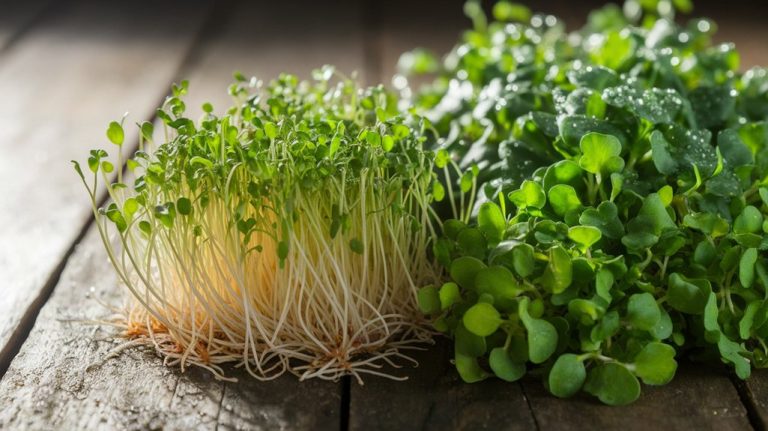Top 10 Sprouts Every Kitchen Should Have
When stocking my kitchen, I always include alfalfa, broccoli, radish, mung bean, clover, pea shoots, sunflower, chia, and mustard sprouts. Each offers unique flavors and nutritional benefits. Alfalfa adds a fresh crunch, while broccoli is known for its cancer-fighting compounds. Radish sprouts bring a zesty kick, and mung beans provide a satisfying crunch. These versatile ingredients can enhance salads, stir-fries, and sandwiches. Stick with me to find out even more about their uses and benefits!
Key Takeaways
- Alfalfa sprouts: A nutritious addition for salads and sandwiches, offering vitamins A, C, E, and K with a fresh flavor.
- Broccoli sprouts: High in sulforaphane, they provide potential cancer-fighting benefits and can enhance smoothies and stir-fries.
- Radish sprouts: With a spicy kick, they add vitamin C and crunch to salads, soups, and sandwiches.
- Mung bean sprouts: Versatile and crunchy, perfect for stir-fries, salads, and wraps, offering a mild flavor.
- Pea shoots: Rich in vitamins C and K, they elevate salads and stir-fries with their tender texture and fresh taste.
Alfalfa Sprouts
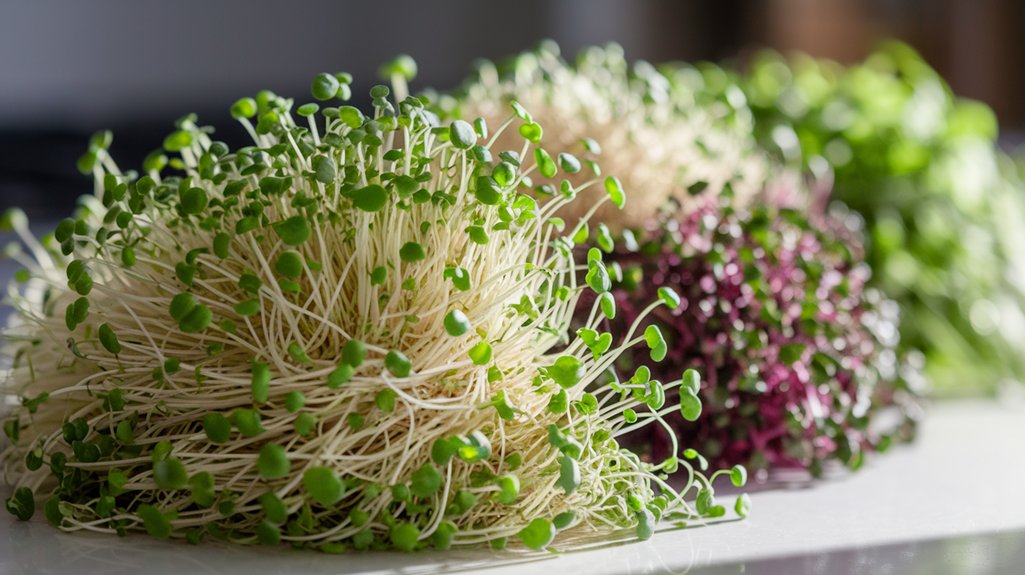
When I think about versatile ingredients to keep in my kitchen, alfalfa sprouts always come to mind.
These tiny greens pack a nutritional punch, offering vitamins A, C, E, and K, along with essential minerals. I love tossing them into salads for a crunchy texture or adding them to sandwiches for a fresh flavor boost. They’re not just tasty; they’re also low in calories, making them a guilt-free addition.
Plus, they’re incredibly easy to grow at home, needing just a jar and some water. I keep a batch on hand, so I can add them to smoothies or grain bowls for an extra layer of nutrition.
If you haven’t tried alfalfa sprouts, you’re missing out on a kitchen staple!
Broccoli Sprouts
While I often reach for alfalfa sprouts, broccoli sprouts have also carved out a special place in my kitchen. These tiny powerhouses are packed with nutrition, offering a flavorful crunch that complements salads and sandwiches beautifully.
What I love most is their high levels of sulforaphane, a compound linked to numerous health benefits, including potential cancer-fighting properties.
Incorporating broccoli sprouts into my meals is effortless. I toss them into smoothies for an extra nutrient boost or sprinkle them on avocado toast for added texture. They’re also a fantastic addition to stir-fries, giving dishes a fresh twist.
Since they’re easy to grow at home, I often keep a jar sprouting on my kitchen counter. Trust me, once you try them, you’ll be hooked!
Radish Sprouts
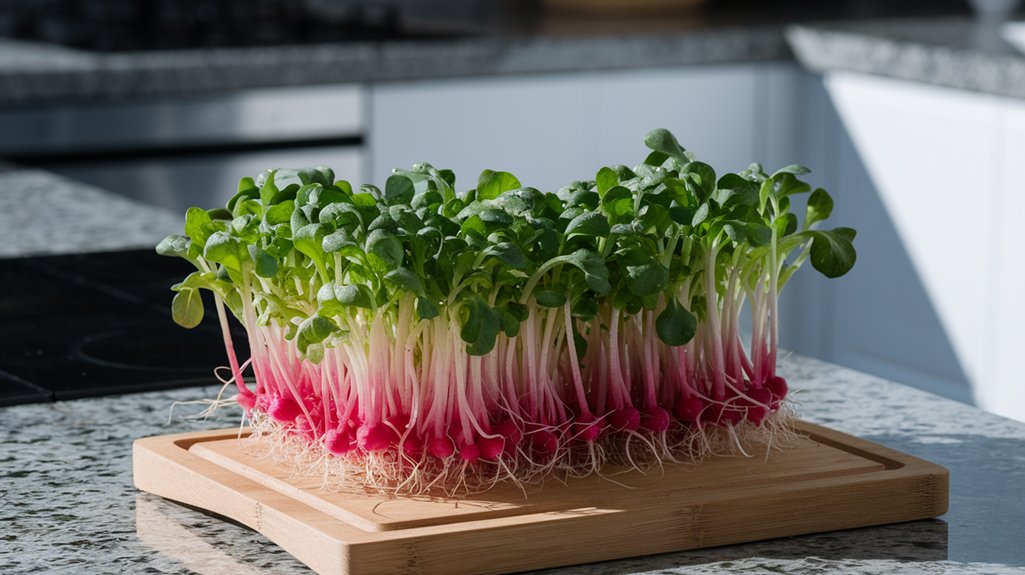
I’m excited to share the benefits of radish sprouts, which pack a nutritional punch and add a spicy kick to any dish.
You can easily incorporate them into salads, sandwiches, or even as a garnish for soups.
Plus, growing radish sprouts at home is simple and rewarding, making them a must-have for every kitchen.
Nutritional Benefits of Radish
Although many people overlook radish sprouts, they’re a powerhouse of nutrition that can easily elevate your dishes. Packed with vitamins and minerals, these tiny sprouts offer a range of health benefits. They’re particularly high in vitamin C, which supports your immune system, and they’re rich in antioxidants that help combat free radicals.
Here’s a quick breakdown of their key nutritional components:
| Nutrient | Amount per 100g | Benefit |
|---|---|---|
| Vitamin C | 14 mg | Boosts immune function |
| Fiber | 1.6 g | Aids digestion |
| Antioxidants | Varies | Protects against cell damage |
Incorporating radish sprouts into your meals not only enhances flavor but also brings a burst of nutrition. Give them a try!
Culinary Uses and Recipes
Radish sprouts not only bring impressive nutritional benefits to the table but also add a vibrant touch to a variety of dishes.
I love incorporating them into my meals for their peppery flavor and crunch. Here are some culinary uses I find delightful:
- Salads: Toss radish sprouts into your favorite green salad for an extra zing.
- Sandwiches: Use them as a fresh topping on sandwiches or wraps for added texture.
- Soups: Garnish soups with a handful of radish sprouts to enhance both presentation and flavor.
- Stir-fries: Stir in radish sprouts just before serving for a crisp finish on stir-fried dishes.
With these ideas, you’ll enjoy experimenting with radish sprouts in your kitchen!
Growing Radish Sprouts at Home
Growing your own radish sprouts at home is a rewarding experience that not only enhances your meals but also connects you to the food you’re eating.
To get started, you’ll need radish seeds, a jar, and some cheesecloth. Rinse the seeds and soak them in water for about four hours. After draining, place them in the jar and cover it with cheesecloth.
Rinse and drain the seeds twice a day, keeping the jar in a dark, well-ventilated area. In about five to seven days, you’ll see your sprouts ready to enjoy!
Use them in salads, sandwiches, or as a garnish. Fresh radish sprouts pack a peppery punch, adding flavor and nutrition to your everyday dishes.
Mung Bean Sprouts
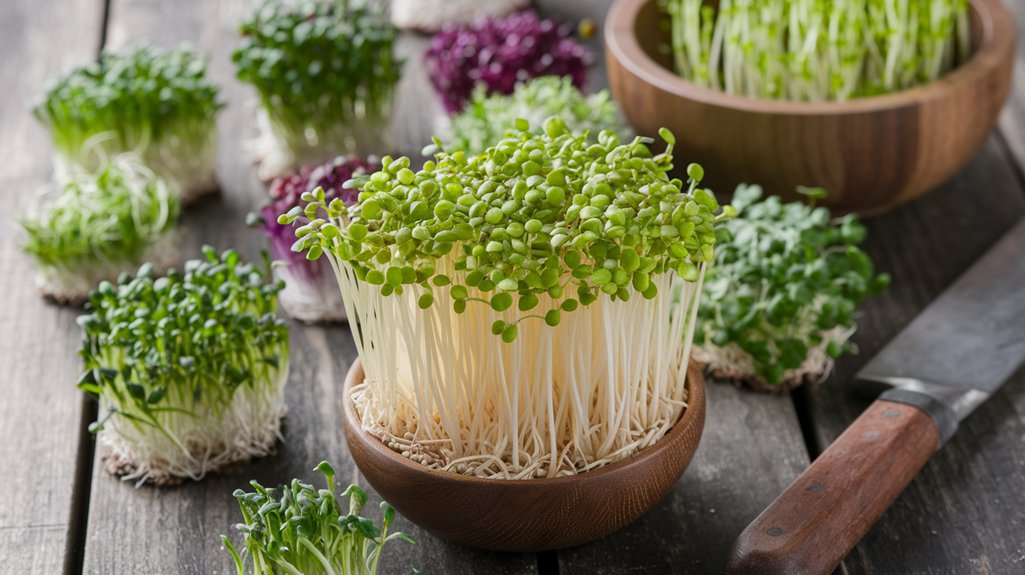
When I think of versatile ingredients that can brighten up any dish, mung bean sprouts always come to mind.
These crunchy, nutrient-packed sprouts add a delightful texture and flavor to various recipes. Here are four ways I love to use mung bean sprouts in my cooking:
- Stir-fries: They cook quickly and absorb flavors beautifully, making them perfect for any stir-fry.
- Salads: Tossing them into a fresh salad adds a satisfying crunch and a burst of nutrition.
- Wraps: I often use them in wraps for an added layer of freshness and fiber.
- Soups: They’re fantastic in soups, adding both texture and a nutritional boost.
Incorporating mung bean sprouts into my meals always elevates the dish!
Clover Sprouts
Although clover sprouts might not be as well-known as other varieties, I find them to be a delightful addition to my kitchen. Their mild, slightly peppery flavor enhances salads, sandwiches, and wraps, making them incredibly versatile. Plus, they’re packed with nutrients like vitamins A, C, and K.
Here’s a quick comparison of clover sprouts with other popular sprouts:
| Sprout Type | Flavor Profile | Nutritional Benefits |
|---|---|---|
| Clover Sprouts | Mild, slightly peppery | Rich in vitamins and antioxidants |
| Broccoli Sprouts | Earthy, nutty | High in sulforaphane |
| Radish Sprouts | Spicy, zesty | Packed with vitamin C |
| Alfalfa Sprouts | Fresh, light | Good source of fiber |
Clover sprouts not only elevate dishes but also offer health benefits, making them a must-try!
Lentil Sprouts
While clover sprouts add a mild flavor to my meals, lentil sprouts bring a hearty, nutty taste that I absolutely love.
They’re not just delicious; they’re packed with nutrients and super easy to incorporate into various dishes.
Here are four great ways I enjoy lentil sprouts:
- Salads: Their crunch adds texture and depth to my favorite greens.
- Wraps: I toss them in wraps for an extra protein punch.
- Soups: They’re a fantastic addition, enhancing both flavor and nutrition.
- Stir-fries: I sprinkle them in towards the end for a delightful crunch.
Lentil sprouts are a versatile ingredient that elevates my cooking and keeps my meals exciting and nutritious!
Pea Shoots
Pea shoots are a delightful addition to any kitchen, bringing a fresh, sweet flavor that brightens up dishes. I love tossing them into salads, stir-fries, or even as a garnish on soups—they add a vibrant touch! Here’s a quick overview of their benefits:
| Nutrient | Amount per 100g | Health Benefit |
|---|---|---|
| Vitamin C | 60 mg | Boosts immune system |
| Vitamin K | 24 mcg | Supports bone health |
| Folate | 68 mcg | Aids in cell function |
| Fiber | 3.6 g | Promotes digestive health |
| Protein | 5 g | Supports muscle repair |
Incorporating pea shoots into your meals is an easy way to enhance both flavor and nutrition. Give them a try—you won’t be disappointed!
Sunflower Sprouts
Sunflower sprouts are a fantastic addition to any kitchen, offering a nutty flavor and a delightful crunch that can elevate a variety of dishes.
I love incorporating them into my meals for their versatility and nutritional benefits. Here are four great ways to enjoy sunflower sprouts:
- Salads: Toss them into your favorite salad for a fresh, crunchy texture.
- Sandwiches: Layer them in your sandwiches or wraps for added flavor and nutrition.
- Smoothies: Blend them into smoothies for a protein boost without altering the taste.
- Garnishes: Use them as a garnish on soups and grain bowls for a pop of color and flavor.
These sprouts not only taste great but also pack a punch of vitamins and minerals!
Chia Sprouts
Chia sprouts are a nutrient powerhouse that I can’t get enough of, adding a mild, nutty flavor to my meals. Packed with omega-3 fatty acids, fiber, and protein, they’re an excellent addition to my diet.
I love tossing them into salads, smoothies, or even on top of avocado toast for an extra crunch. One of the best parts? They’re super easy to grow at home! All you need are chia seeds, water, and a sprouting tray or jar.
In just a few days, you’ll have fresh sprouts ready to enjoy. Plus, they’re incredibly versatile. You can use them in sandwiches, wraps, or even as a garnish for soups.
Trust me, once you try chia sprouts, you’ll be hooked!
Mustard Sprouts
Mustard sprouts are a powerhouse of nutrients that can elevate your meals and health.
I love incorporating them into salads and sandwiches for a zesty kick, and they’re super easy to grow at home.
Let’s explore the amazing benefits they offer and some delicious ways to use them in your cooking!
Nutritional Benefits of Mustard
When it comes to adding a nutritional powerhouse to your kitchen, mustard sprouts deserve a spot on your grocery list.
These tiny greens pack a punch when it comes to health benefits. Let me share some key reasons why you should include them in your diet:
- Rich in Vitamins: Mustard sprouts are loaded with vitamins A, C, and K, which support your immune system and promote healthy skin.
- High in Antioxidants: They’re packed with antioxidants that help fight oxidative stress in your body.
- Great for Digestion: The fiber content aids digestion and keeps your gut healthy.
- Low in Calories: With their low-calorie count, they’re perfect for weight management.
Incorporating mustard sprouts into your meals is both nutritious and delicious!
Culinary Uses and Recipes
After discovering the impressive health benefits of mustard sprouts, you might be wondering how to incorporate them into your cooking. These tiny greens pack a punch of flavor and can elevate various dishes. Here are a few simple culinary uses and quick recipes to get you started:
| Dish | Use of Mustard Sprouts | Recipe Idea |
|---|---|---|
| Salad | Add a fresh crunch | Toss with cherry tomatoes and vinaigrette. |
| Sandwich | A zesty layer | Layer between turkey and avocado. |
| Stir-fry | Add at the end for texture | Combine with veggies and tofu. |
| Soup | Garnish for a spicy kick | Sprinkle on top of miso soup. |
| Omelet | Mix in for added flavor | Whisk into eggs and cook. |
Give them a try, and you’ll love the flavor they bring!
Growing Mustard Sprouts at Home
Growing mustard sprouts at home is surprisingly easy and rewarding. I’ve found that these spicy little greens add a delightful kick to salads and sandwiches.
Here’s how you can get started:
- Choose Your Seeds: Look for organic mustard seeds at your local garden center or online.
- Prepare Your Tray: Use a shallow tray with drainage holes and fill it with moist soil or a sprouting medium.
- Sow the Seeds: Scatter the seeds evenly across the surface and lightly press them into the soil.
- Water and Light: Mist the seeds to keep them damp and place the tray in a sunny spot.
In just a week, you’ll have fresh mustard sprouts ready to enjoy! It’s that simple!
Frequently Asked Questions
How Long Do Sprouts Typically Last in the Refrigerator?
I’ve found that sprouts typically last about 3 to 5 days in the refrigerator.
It’s best to store them in a breathable container, like a paper bag or a perforated plastic bag, to keep them fresh.
I always give them a quick rinse before use, which helps maintain their crispness.
If they start to smell off or get slimy, I toss them—better safe than sorry!
Enjoy your sprouts while they’re still fresh!
Can I Grow Sprouts Indoors Without Sunlight?
Absolutely, you can grow sprouts indoors without sunlight! I’ve done it myself, and it’s surprisingly easy.
Just use a jar with a mesh lid for drainage, soak your seeds overnight, and rinse them a couple of times a day.
Keep them in a warm, dark place until they sprout. In just a few days, you’ll have fresh, nutritious greens ready to enjoy in salads or sandwiches.
It’s a fun and rewarding project!
Are There Any Allergens Associated With Sprouts?
Absolutely, there can be allergens associated with sprouts.
I’ve found that some people may experience allergic reactions, especially to common varieties like alfalfa or clover sprouts. Symptoms can range from mild digestive discomfort to more severe reactions.
It’s always wise to start with small amounts if you’re trying a new type of sprout. If you have known allergies, checking with a healthcare professional can help ensure you stay safe while enjoying these nutritious additions to your diet!
What Is the Best Way to Wash Sprouts?
When I wash sprouts, I always start by rinsing them under cold running water.
I gently agitate them with my hands to ensure I remove any dirt or debris. After that, I drain them in a colander and give them a few shakes to remove excess water.
If I want to be extra cautious, I sometimes soak them for a few minutes before rinsing again. This way, I know they’re clean and ready to enjoy!
Can I Freeze Sprouts for Later Use?
Absolutely, you can freeze sprouts for later use! I’ve done it myself, and it’s quite simple.
Just wash them thoroughly, blanch them in boiling water for a couple of minutes, then plunge them into ice water to stop the cooking process.
After draining, I pack them in airtight bags and toss them in the freezer. They’re perfect for adding to soups or stir-fries later on.
Just remember to label the bags!
Conclusion
Incorporating these top 10 sprouts into your kitchen can truly elevate your meals, adding both flavor and nutrition. Whether you’re tossing them in salads, blending them into smoothies, or using them as a garnish, each sprout brings its own unique benefits to the table. So, why not give them a try? You might just discover a new favorite ingredient that transforms your cooking and boosts your health. Happy sprouting!

